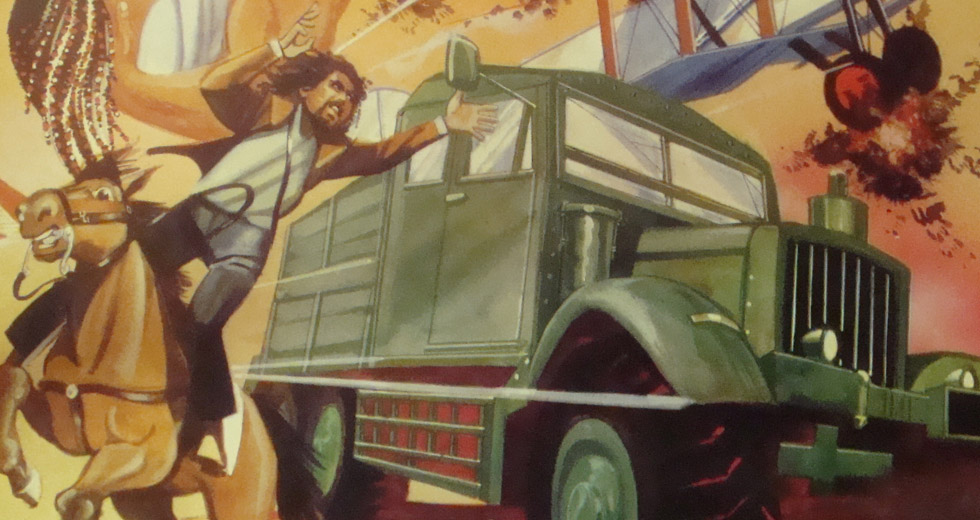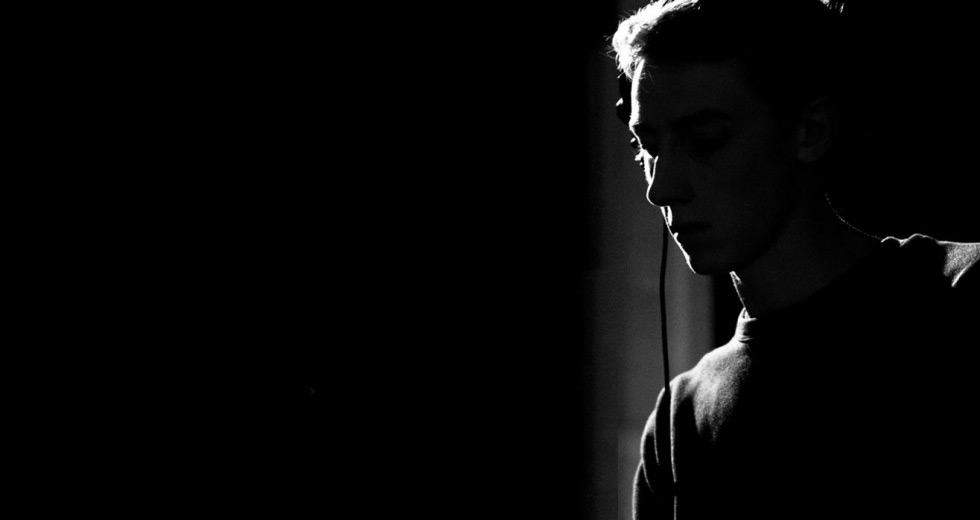Interview: Dommune’s Ukawa Naohiro
An insight into the mind behind one of the world’s most influential streaming networks.
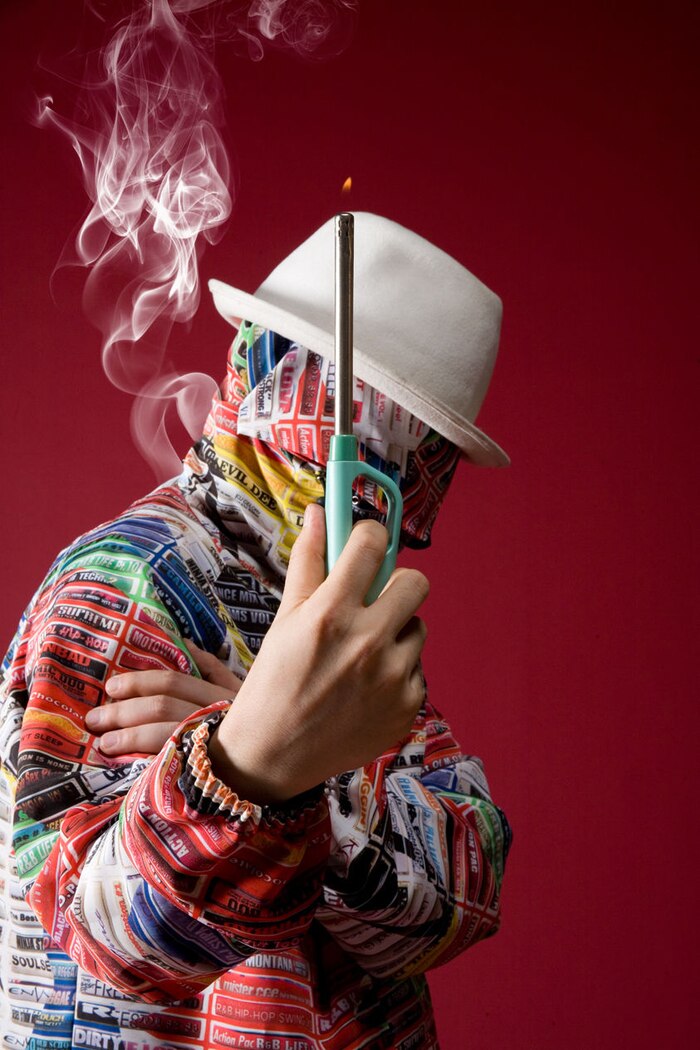
Beginning his career as a VJ for the Boredoms in the late ’80s, Ukawa Naohiro has established himself within the Japanese music scene as a creator of a visual groove. His many job titles include graphic designer, writer, university professor, club owner, program producer, party organizer, visual artist, and music video director. With regards to the latter, he has produced in the neighborhood of 100 music videos for groups such as the Boredoms, The Orb, Denki Groove, and Scha Dara Parr among others, and is currently the mind behind live streaming studio DOMMUNE.
DOMMUNE began test broadcasts in October of 2009, and from March the following year officially started streaming from a basement studio in Shibuya, two months before the Softbank-funded Ustream Asia and six months before Boiler Room, making it a pioneer in the field of live streaming studios. Programming for the endeavor was heavily influenced by Ukawa’s experiences in the Tokyo club scene since the ’80s.
The program began with talk shows by scholarly and cultural luminaries from across the world, neuroscientists, sociologists, even avant-garde artists, with notable names such as Alexandro Jodorowsky and Hermeto Pascoal. The second half of the program was live mixes by DJs and musicians from within Japan and abroad such as Derrick May, Nina Kraviz, Carsten Nicolai, Merzbow, Keiji Haino, and DJ Nobu among others. From Monday to Thursday, Ukawa opens up the live stream to the world through social media to share his intellectual and musical experiences through each day’s guest appearances. For five years, usually up to or exceeding five hours per day of programming, Ukawa has captured the visuals and manned the switchboards at his studio, which boasts a sound system comprised of pieces by Funktion-One and Master Blaster. These years of persistence has amounted to over 5,500 hours of material stashed within his hard drives. The broadcasts continue to this day, and each day brings an average of about 10,000 viewers, totalling close to 45 million served.
Along with his multimedia campaign, Ukawa has been active in the world of contemporary art, presenting works at solo and group shows in Japan as well as overseas. In this interview, presented as a monologue, Kiki Kudo delved into the history of Ukawa and how it relates to his current project DOMMUNE and his work as a conceptual artist.
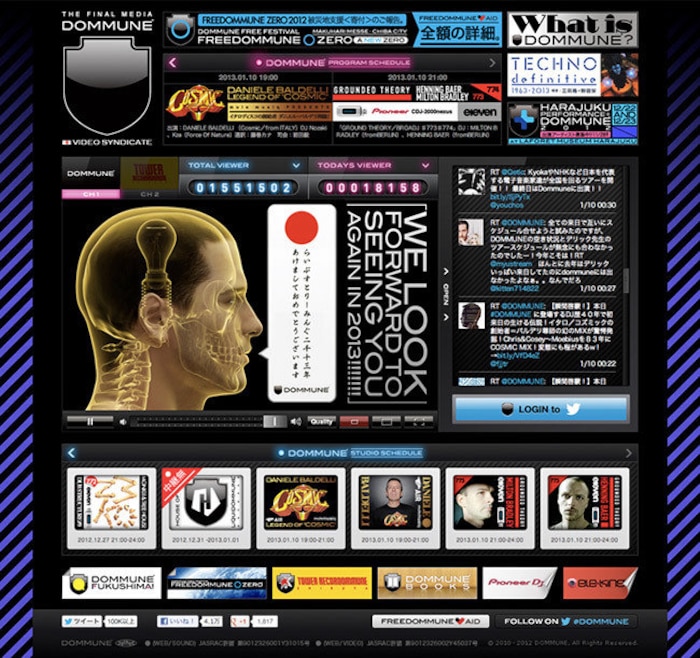
Back when DOMMUNE first started, it was my conviction that we were the “real” public broadcasters.
Even before we had begun our broadcasts we had obtained rights codes for our live streaming as well as for our archived contents from JASRAC, but we haven’t been using them. This was due to our obsession with staying true to providing material for the creative commons through the newest form of expression at the time which was live streaming. As the year of our establishment (2010) was the dawning of the social media age, we began DOMMUNE with the pioneering spirit similar to the beginnings of the TV age in the Showa era before home video gave the viewer greater control of content.
DOMMUNE was created to make something tangible which multiple people shared simultaneously in a global media environment. I see a comeback for the popular phrase “ナウ(the Japanese phonetical spelling for ‘now’)” in social media such as twitter from the days when it was used as the title of programs such as Ginza NOW! circa 1972. Because live streaming to me is an aura of sorts, I felt that as a method to express the “now,” it would disturb or defile things to release five years and over 5,500 hours of programming into cyber space. Back when DOMMUNE first started, it was my conviction that we were the “real” public broadcasters. [laughs] What I mean by that is, thanks to live streaming over the web, we were able to broadcast regardless of old broadcast laws.
If cyber space is the “public” for digital networks, then we are broadcasting content to a borderless street scene. If you look back in history, the Lumière brothers were founders of cinematography in 1894. Its DNA has come a long way through the silver screen and then onto color. It further evolved into televisions, which entered people’s homes first as a staple of the living room and then onto a more personal level where it shed the cathode-ray. It morphed into digital broadcasting, which enabled viewing on laptops and smart phones. My vision of the current live streaming environment harkens back to Edison and the kinetoscope in the late 1800s. So in my mind DOMMUNE began its operation as a way to create a chaotic mixture and transmutation of the single person “peeping” effect of the kinetoscope in the form of a laptop combined with the broad synchronicity of time through live social media. [laughs]
I thought that YouTube was a revolution, because it erased “rarity” as a concept from the lexicons of media history.
I thought that YouTube which began in 2005 was a revolution, because it erased “rarity” as a concept from the lexicons of media history. Visual and audio media ceased to be a personal belonging and instead became common property. It used to be that by simply possessing “rare” media, it became a facet of your own self-expression. YouTube has done away with that. Your content is my content, my content is your content! Your time is my time, my time is your time! The vastness of cyberspace and its ability to archive and share the “past,” has turned all content on YouTube and other media archives into something which can be “viewed later.” Therefore if somebody owns something, it is yours, and content which can be “viewed later” is not being “seen now.” This is the reason why I have rejected releasing my archives. Instead I have provided new content, constantly creating time which can only be “seen now” and not “viewed later”! Let us share “now”! My time is my time! Your time is your time! “Time is golden!” The time that you have everyday is an extremely valuable personal asset.

I believe since I started this project that every aspect of the programming, the act of capturing the audio and visual, the act of streaming it live, and the act of recording what goes on here in the studio is “current art.” It is “current art” because it keeps progressing at a speed at which “modern art” can not keep pace with. DOMMUNE is “current” and not “modern” because it is a live work of art which is always true to the “here” and “now.”
In 1929, Dziga Vertov’s Man with a Movie Camera put the kinoks and their film ideology on the map. I sought to be the “Man that Placed the Movie Camera” by filming all the programs on the same canvas with the same lighting, making all the programs a high fidelity portrait and a fixed point portrait of various artists who lived in the same timeframe. Therefore, DOMMUNE is a neo-kinok interpretation in the SNS era, where the real-time switching of visual feeds marks it as being “post-montage” and in the live streaming generation.
I found out DOMMUNE was not a “search” but a “retrace.”
In 1970, Jonas Mekas established the Anthology Film Archives, which led to my understanding of archive as being “a place to enjoy film with others.” This godfather of experimental film in America still records parts of his day on his favorite Bolex with hopes of finding himself and sharing the journey with others. Being a supporter of Mekas’s philosophy, I participated in the ten year anniversary of the Yamaguchi Center for Arts and Media (YCAM) which was directed by Ryuichi Sakamoto. My contribution to the project was called YCAMDOMMUNE which was to renovate a building that had been a McDonald’s and a supermarket into a DOMMUNE satellite studio, archive theater, gallery and bar from which I conducted many satellite broadcasts.
Before that, I also set up a satellite studio in Dortmund, Germany for a month on invitation from the ministry of culture at a studio called “U” where I also released the archives. The broadcasts are a format which usually targets users individually. The release of the archives happened in a setting where people could come to a space where they could view the programs with others. As a person who respects the aura which art carries, I have always “displayed” the archives in a physical space or “white cube,” a space where people can bring themselves to share the experience of the archives. However, after seeing the reception at these two satellite venues, I understood that a series of two hour programs with no set story or connection besides the fact that it stayed true to the DOMMUNE philosophy was a challenge to viewers’ abilities to maintain concentration and interest.
I found out DOMMUNE was not a “search” but a “retrace.” Every program created was a piece in a momentous self-history, and an epoch within a larger cultural history. DOMMUNE is my version of Jean-Luc Godard’s Histoire(s) du cinéma, a perspective constructed from a personal context which took a long time to edit and covers an even larger swath of material. This is why I keep expanding the content daily as a part of my life’s work.
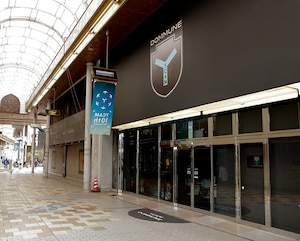
Expansion…? How and where to shall I keep expanding this already massive work? A clue to answering this question is another question which is “Why did Taro Okamoto not sell his art?” His originals are not able to be owned by a single person. I thought that the answer to my problem was hidden somewhere in the motives of Taro Okamoto. I have heard that Mr. Okamoto’s reason for not creating art for private collectors was that he wanted many people to view his art and that his work not end up “buried and forgotten” to the world in someone’s collection. Mr. Okamoto’s words – “buried and forgotten” – still possess and torment me even after five years of broadcasting. “Buried and forgotten” are words which can be said to describe DOMMUNE archives after a program goes off the stream. Put differently, the act of being seen by living eyes is what gives life to works of art.
The act of being seen by living eyes is what gives life to works of art.
This is the reason why I attempt to present the archives in a “white cube’” where people can come to visit and give life to past programs, but after the presentation is finished the only person who can view the programs is myself. I have continued to be pure in my belief towards art, but I feel at times the stagnation brought about by being the only one who can access the archives is akin to me, the artist, keeping his work “buried and forgotten.” Many of Taro Okamoto’s works are displayed outside of galleries as public art. Public art is free, there is no discrimination and it is the possession of all human beings. Are the answers to the handling of the “archives” there? I remain in thought over this “modern” or more accurately, “current” problem regarding joint ownership.
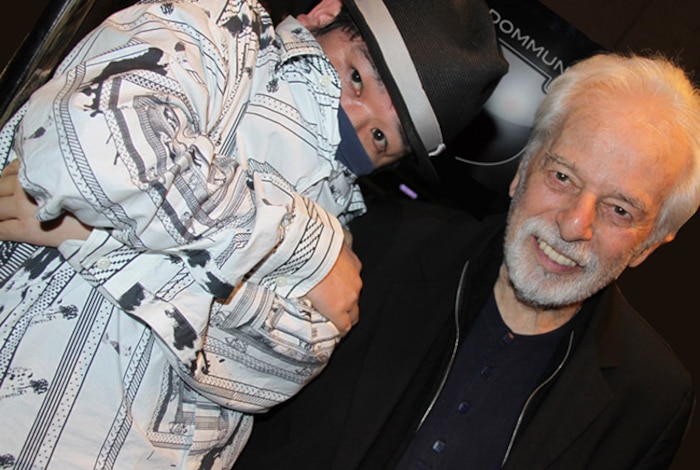
By continuously asking and answering my own questions regarding the archives, I was able with the help of UPLINK to meet Alejandro Jodorowsky, a man for whom I hold much reverence. I was actually able to have him appear on a live stream. Being a denizen of DOMMUNE which continually presents the greats from many genres global and local, I had become numb to things like nationality, social standing, fame, and being nervous, but this was a day which straightened my spine. Our studios being a minute away from where the Aum Shinrikyo cult had their Aoyama location makes it a strange “power spot” of sorts and being able to meet and ask questions to a person whom I considered to be a teacher was fitting in a way. So I asked him, “I have put many of my different careers on hold and for four and a half years I have continued streaming live as my way to express ‘modern art.’ Sleeping with technology, creating programming at a pace which doesn’t allow for proper digestion of the material, and still seeing it as a cultural legacy, which to me is DOMMUNE, is this art? What is art?”
Mr. Jodorwsky answered me. “Art is a frog which has swallowed a luminescent insect. Frogs live in darkness, and look up at the moon, and when they find an insect that gives off light, they eat it. It is like an artist that is seduced by the light of creativity! It takes time to digest this light… but sooner or later they will produce beautiful shining crap!” [laughs] He continued. “We as animals will eat and will deposit feces, we just do not know when… but eventually we will crap modest light which in turn will fertilize the seeds of the next creation! The importance is the seeds and to keep sowing them, keep sowing the seeds with reckless abandon!” [laughs]
I have been stockpiling and fermenting my “shit” for five years. My archives now exude a funk which has substance, depth, and most of all is overwhelming.
So DOMMUNE is a frog, which consumes the artists which pass through it (videography), and shits it out without proper digestion (broadcast), into a dung heap called the hard drive (archives). This “shit” will hakkou [Japanese homonym for “fermentation” and “illumination”] and then it will shouka [homonym for “sublimate” and “digest”], an aging process which DOMMUNE has been repeating since its establishment. I was silently hit with this epiphany while listening to Mr. Jodorowsky’s words and knew that I had to keep sowing the seeds into the world! I had to continue my broadcasts! If I kept making my programs, DOMMUNE will continue to be a work of art, as my efforts to broadcast the various artists who pass through my studio become the act of blindly sowing seeds, making the whole process “artcore alchemy”! [laughs] In summation I feel it is time for me to release my archives! I understand that reopening the “dark underbelly” of Japan, the modern age, and art is intriguing, as is the importance for a premeditated market heavy strategy, but as a petty artist I believe strongly in the theories bestowed to me by Mr. Jodorowsky. I just want to see the sun rise over the “holy mountain”...
For example, Boiler Room has maintained the concept of networking as its main thesis. The archives were important in this context as in a global view, it was crucial for them to make available their programming beyond the restriction of time zones. I have already mentioned our stubborn obsession with the “current” as to why we do not release our archives. However in a world where SNS has become the norm, or the “sharing of now” has become the norm, it seems the time is ripe for us to reevaluate our stubbornness. It was at this precipice where Mr. Jodorosky’s teachings were handed down and affected me greatly. I have been stockpiling and fermenting my “shit” for five years. [laughs] My archives now exude a funk which has substance, depth, and most of all is overwhelming. [laughs] So the archives which I had been splattering across the “white cubes” in the past were lukewarm at best. It had to be fermented further so it could sublimate properly as fertilizer which could be sown into minds of viewers worldwide in a format where it could be properly digested and become parts of their body and soul. [laughs] DOMMUNE has been constant in this aging process.
What becomes important here is the format which we have maintained since DOMMUNE’s establishment and that is the talk program we have in the first half and the music program we have in the second half. I see this as an invention of sorts. It’s as if those two halves of the program were different food groups… for example the talk portion of the program would be the proteins, fibers, and minerals which comprise the body and the brain, while the music portion of the program becomes the energy, carbohydrates, and sugars. The archives have been fermenting these elements, making the archive an organic cultural fertilizer! When I think about it now, I think it was the music portion of the program which became energy that transcended linguistic boundaries, and the people who were able to absorb that energy were able to grow their own live streaming music formats across the world.
DOMMUNE and Boiler Room did several collaborative broadcasts in Tokyo this year. The creator of Boiler Room, Blaise and the female MC... Sofie, she informed me that we had started half a year before Boiler Room did. [laughs] Yes, it does feel good to know that you are the originator of something and you were able to send energy to the world in a new way, but to think that mankind, living in the same era and given the same technology wouldn’t sooner or later come up with similar original concepts is nonsense. For example, who was the original – Paradise Garage or the Warehouse – should not be the issue. Their concepts are different, so they will both be recorded in world history. The strength of Boiler Room was that it kept the global network in perspective. DOMMUNE is now connected to their global network and we intend to collaborate with them again in the future. However, I feel that the reason why DOMMUNE still has a relatively large audience is due to the fact that it’s still “rare.” A “rare” steak is meat that hasn’t been cooked too thoroughly and is still close to being nama [homonym for “raw,” “live,” or “life”]. Content with value “currently” or things “worth” seeing “now” is footage which is “nama” and will have gone bad tomorrow, so “raw” footage is footage which is “alive.” This is the reason why I see the power of live streaming as “living currently, without doubt.”
DOMMUNE is my most recent form of expression. Day in, day out, I create living portraits of living artists of the same era on the same canvas with the same lighting and the same camera setup. This is the reason why my art is current and not modern, while also being a work of art which is a performance as well as a concept.
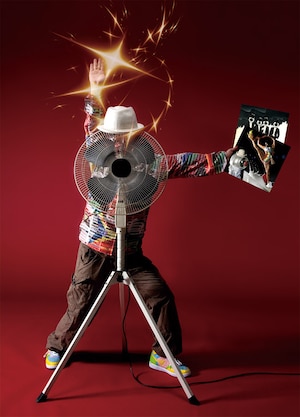
Boiler Room continues to connect the world’s dancefloors to the public. DOMMUNE continues to connect Ukawa Naohiro’s super-ego mind space to the world. However Ukawa’s concepts were also present in his previous work. Point observation and capture, surveillance and voyuerism, conciousness and subconciousness, the connection between personal and public… resulting in the love for numbers which borders on fetishism. These can be said to be the hallmarks of Ukawa’s works of art.
In 2003 Ukawa premiered his piece Daily Psychic TV / Emperor’s Dead in a makeshift gallery at fashion brand Lad Musician which was later refined for its presentation at the Tokyo Metropolitan Museum of Photography. The latter was comprised of 54 installations of Ukawa’s personal ’70s era “ra-te-casse” (radio-tv-cassette) which broadcast, received, and played six hour loops of the NHK program announcing the passing of Emperor Showa. The broadcast at the time was done through a video transmitter, which meant anybody in a 300m radius with a TV could also receive the transmission. It was a pirate broadcast predating the live stream, which can be understood as a primitive incarnation of what will later become his daily life work and expression of “current art,” DOMMUNE.
I already had many works which became the foundations for DOMMUNE. One of them was !!!UZULIVE!!! (2004), where I recorded the mating calls of my pet quail, digitally altered the audio and played it back to my pet quail while recording it all with a surveillance camera. I did another piece where I projected a female face [interviewer of the piece, Kiki Kudo] being told a horror story adlibbed by myself onto the whole side of the building. That became SUPERNATURAL DELUSION.
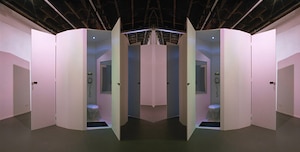
As a part of Japan-Australia Cultural Exchange year I presented Dr. Toilet’s Rapt-up Clinic (2006) in Melbourne, which was a mandala-shaped installation comprised of five port-a-potties lined with one way mirrors and surveillance cameras. It was a heavily criticized installation, which also involved a five hour audio program of various TV shows from across the world (with significant audio delay) together with a “syncro energizer” comprised of sound waves that trigger alpha waves in the brain. This was played in the port-a-potties while the footage from participants “meditating” in the installation was archived in a hard drive. It was a very ironic installation that tried to portray the disgraceful side of Japan in Melbourne at a time where Professor Uekusa was put under the spotlight for a voyeur incident [accused for using a hand mirror to peep under a woman’s skirt on an escalator]. It was also a piece which was a mechanism to make the public and private borderless, while at the same time questioning the relationship between public and private in a surveillance society.
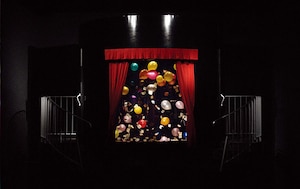
I have also done projects which were based around natural disasters. At the Mori Art Museum, I captured a live hurricane in A Series of Interpreted Catharsis Episode 1: Hurricane - Katrina by videotaping participants sitting in a machine which reproduced the parameters of Hurricane Katrina. A Series of Interpreted Catharsis Episode 2 - Earthquake was a recreation of the Kobe Earthquake and San Francisco Earthquake at the Earthquake Research Laboratory in Tsukuba which was filmed with a high-speed camera.
With the passing of Mr. Kawara, a forerunner for me in modern art, my spirit was broken slightly.
DOMMUNE is undoubtedly an extension of my previous works. I would also like to voice condolences for Onn Kawara, a modern artist which I have great respect for who passed away recently. Because DOMMUNE is an expression of my respect for art through my performance in the studio day in and day out, I am really left with a strong impression of Mr. Kawara’s concepts regarding time, space, existence and life. DOMMUNE similarly will not be broadcast if I died. [laughs] So if it’s being broadcast it means I AM STILL ALIVE [a series by On Kawara] and the program that is being broadcast is like Mr. Kawara’s Date Paintings but more like Date Shooting and I have been doing that for five years straight. In a way my work is being updated everyday with the streams which I put up, but with the passing of Mr. Kawara, a forerunner for me in modern art, my spirit was broken slightly. The notice of his passing left me in a quandary. I felt that his existence could be carried on much in the same way names for kabuki and rakugo performers are handed down throughout generations. If this were the case with Mr. Kawara TODAY would be ongoing and I AM STILL ALIVE would be forever.
He began his Date Paintings in 1966, and since then had shunned interviews and portraits of himself. Few people had proof of his existence, so I thought he would never die. As I keep adding to my archive of DOMMUNE streams I sometimes wonder, “When is this complete?” An artist’s work will live on forever. Or, more accurately, the work will live on of its own accord in the minds of its users after it leaves the presence of the artist that created it. Mr. Kawahara’s work was completed on the day of his death. I think, “What about DOMMUNE?”
This autumn, I tackled the archive problem head on with the DOMMUNE University of the Arts: Tokyo Arts Circulation at 3331 Arts Chiyoda. Under the title THE 100 JAPANESE CONTEMPORARY ARTISTS, we did a gallery showing portraits and works of the 100 Japanese artists. At the same time I made mini documentaries/interviews of several artists called Itsumitemo Gendai Bijyutsu Haranbanjyou [Contemporary Art Is Filled with Ups and Downs Whenever You Stop to Look] as a way to pass on the spirit, philosophy and mannerisms of legends such as Makoto Aida, Norimizu Ameya, Chu Enoki, Kenjiro Okazaki, Motohiko Odani, Onn Kawahara, Tomoko Konoike, Masato Kobayashi, Hiroshi Sugimoto, Keiichi Tanaami, chim↑pom, Noboru Tsubaki, Masato Nakamura, Noriyuki Haraguchi, Kohsai Hori, Mika Ninagawa, Yuko Mohri, Daidoh Moriyama, Kenji Yanobe, and Tadanori Yokoo. I believe this to be a cultural documentation of inexpressible value!
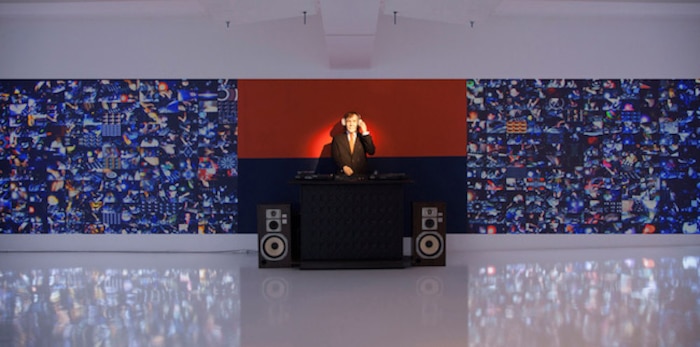
Will these programs become the illumination of Mr. Noi Sawaragi’s thesis in Nihon, Gendai, Bijyutsu (Japan, Contemporary, Art) that the Tojirareta Enkan (Closed Loop, by Naoyoshi Hikosaka) can be made available to the masses? Or will the “contemporary” in Nihon, Gendai, Bijyutsu exhibit a new schism in the paradox of time? The exhibit was met with great success and garnered accolades from many in various communities, but I am looking forward to the catalytic reaction the archives being released will have on the world.
On top of these works I also released the simultaneous restreaming of 1000 DJs from the archives of DOMMUNE under the direction of John Cage in John Cage & The 1000 World Wide DJs. Explaining the concept will take up another two hours, so [laughs] please go look it up, but the project was the dissertation of the “here and now” for DOMMUNE which has been the constant filming, streaming, and recording of artists and musicians over five years. I think that especially the last two works mentioned are projects which exude a never before seen aura in art history which have yet to be attempted by anyone else. If people can feel the body and breathe of 100 artists (of which 20 were part of the documentary) which I have recorded, and the sound of 1000 DJs from the DOMMUNE archives, I feel that even I who lives in this world TODAY can be saved. [laughs] OK, everybody as loud as you can, I AM STILL ALIVE!!!!!!!!!!!!!!
